Categories
Safety Cabinets for Flammables
To help protect your people and facility from a potential fire, Justrite safety cabinets offer superior fire protection for the storage of flammable liquids, aerosols, and other hazardous materials.
Read more
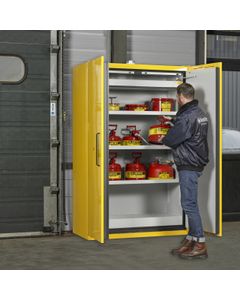
EN Safety Cabinets 90 Minutes 226-EN Justrite safety cabinet for flammable liquids
EN safety cabinets with extreme 90-minute fire resistance for the storage of flammables.
Available in 2 versions
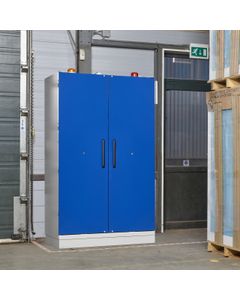
EN Lithium Battery Safety Cabinets - 90 Minutes 226-LT Justrite lithium-ion cabinet
EN Safety Cabinets for high level safety when storing lithium-ion batteries
Available in 3 versions
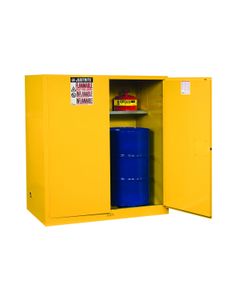
Sure-Grip® EX Vertical Drum Safety Cabinets 89-VD Justrite Yellow No Rollers
OSHA- and NFPA-compliant vertical storage for one or two 110- to 200-L drums
Available in 1 versions
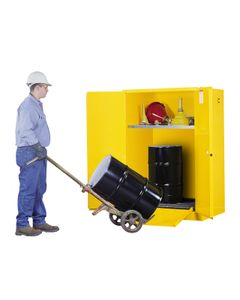
Sure-Grip® EX Vertical Drum Safety Cabinets 89-VD Justrite Yellow Drum Rollers
OSHA- and NFPA-compliant vertical storage for one or two 110- to 200-L drums
Available in 2 versions

Sure-Grip® EX Double-Duty Drum Safety Cabinet 89-DD Justrite
Two separate compartments fit one vertical 200- or 110-L drum and up to twelve 19-L safety cans
Available in 2 versions
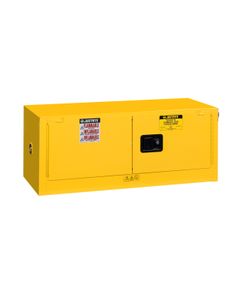
Sure-Grip® EX Piggyback Safety Cabinets 89-PG Justrite safety cabinet for flammable liquids Yellow
Low-height design allows you to store flammables on bench tops or on top of 114- and 170-L cabinets
Available in 4 versions
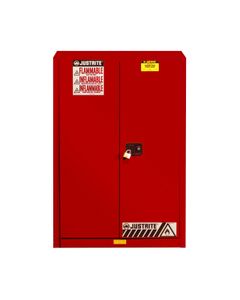
Sure-Grip® EX Classic Safety Cabinets 89-CL Justrite flammable cabinet Red Manual
Protect workers, reduce fire risks, and improve productivity by storing flammable fuels and chemicals in OSHA- and NFPA-compliant safety cabinets.
Available in 1 versions

Sure-Grip® EX Classic Safety Cabinets 89-CL Justrite flammable cabinet Yellow Manual
Protect workers, reduce fire risks, and improve productivity by storing flammable fuels and chemicals in OSHA- and NFPA-compliant safety cabinets.
Available in 5 versions

Sure-Grip® EX Classic Safety Cabinets 89-CL Justrite flammable cabinet White Manual
Protect workers, reduce fire risks, and improve productivity by storing flammable fuels and chemicals in OSHA- and NFPA-compliant safety cabinets.
Available in 1 versions
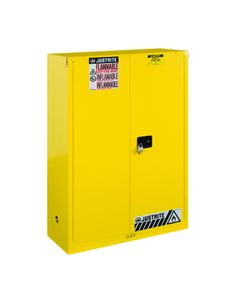
Sure-Grip® EX Classic Safety Cabinets 89-CL Justrite flammable cabinet Yellow Self-close
Protect workers, reduce fire risks, and improve productivity by storing flammable fuels and chemicals in OSHA- and NFPA-compliant safety cabinets.
Available in 4 versions

Sure-Grip® EX Wall-Mount Safety Cabinets 89-WM Justrite safety cabinet for flammable liquids Yellow
Make the most of usable storage space—hang cabinet above workbench for easy access to work solvents
Available in 2 versions

Mini Safety Cabinet 89-MI Justrite safety cabinet for flammable liquids Yellow
Small footprint cabinet safely stores flammables within close reach—relocates easily
Available in 1 versions
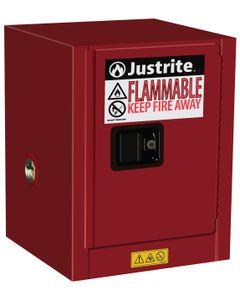
Sure-Grip® EX Countertop Safety Cabinets 89-CT Justrite safety cabinet for flammable liquids Red
Use on workbenches for access to often-used liquids. Compliant, compact design offers same fire protection of larger Justrite cabinets
Available in 1 versions
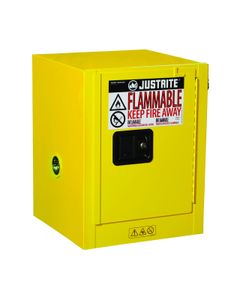
Sure-Grip® EX Countertop Safety Cabinets 89-CT Justrite safety cabinet for flammable liquids Yellow
Use on workbenches for access to often-used liquids. Compliant, compact design offers same fire protection of larger Justrite cabinets
Available in 2 versions
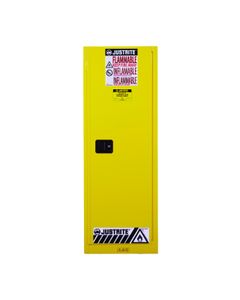
Sure-Grip® EX Slimline Safety Cabinets 89-SL Justrite safety cabinet for flammable liquids Yellow
Safely store flammables when floor space is tight or use to expand storage alongside existing cabinets
Available in 3 versions
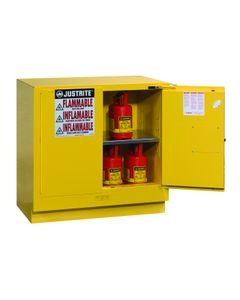
Sure-Grip® EX Undercounter Safety Cabinets 89-UC Justrite safety cabinet for flammable liquids Yellow
Position under a counter to take advantage of storage space and keep liquids near benchtop work space
Available in 2 versions
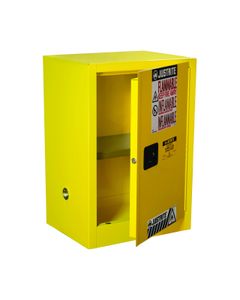
Sure-Grip® EX Compac Safety Cabinets 89-CM Justrite safety cabinet for flammable liquids Yellow
Fire-resistant design includes double-walled steel with 38-mm of insulating air space and 3-point stainless steel bullet latch for positive, failsafe door closure
Available in 4 versions
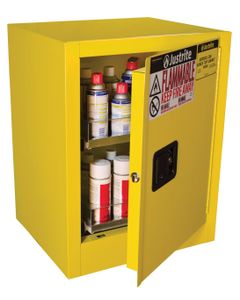
Sure-Grip® EX Benchtop Flammable Safety Cabinet, Cap. 24 aerosol cans, 2 drawers, 1 manual close door, Yellow 89-AB Justrite Yellow
Fits up to 24 cans in two steel roll-out shelves with easy glide plastic rollers and top guard protection.
Available in 1 versions
FAQ about Safety Cabinets for Flammables
Can I store gasoline and oil in the same cabinet?
Yes:
OSHA 29 CFR 1910.106(d)(3)(i&ii):
Design, construction, and capacity of storage cabinets (i) Maximum capacity. Not more than 60 gallons of Class l or Class ll liquids, nor more than 120 gallons of Class lll liquids may be stored in a storage cabinet.
Can I store containers in the sump of a safety cabinet?
Yes. The specifications on the sump only states it be 2-inches deep and watertight. Minimum volume is not addressed. The sump can give a safe visual indication and contain a leak before it becomes a problem, allowing the users to correct the leaking container, and clean up a spill as quickly as possible. There is nothing in writing from OSHA, NFPA, IFC, FM, or UL to limit the use of the sump on a safety cabinet for storage. That is not to say you could not limit its use for storage as an internal safety policy. An official having jurisdiction (State Fire Marshal, Building Inspector Local Fire Chief, etc.) at your site might discourage using the sump for storage. However, there is nothing otherwise to preclude storage in the sump.
What types of chemicals should be stored in these cabinets?
These cabinets are intended to store corrosive solids and liquids, flammable solids, organic peroxide formulations, oxidizer solids and liquids, pyrophoric solids and liquids, toxic or highly toxic solids and liquids, unstable (reactive) solids or liquids, and water-reactive solids or liquids. Always ensure that incompatible materials are stored in separate cabinets, and consult your local code authority for any other items in question.
Does my safety cabinet need to be grounded?
It is necessary to ground a safety cabinet if you are dispensing liquids from container(s) inside the cabinet, and the potential of an ignitable vapor is possible. This is not to preclude one from grounding all cabinets as a best practice. Please see our TechTALK on Safety Cabinet Grounding for further information.
Do I need self-closing cabinet?
Flammable liquid safety cabinets self-close requirement depends on your state's fire code. Hazardous material safety cabinets are required to be self-closed everywhere. As a best practice all safety cabinet should be self-close.
Will my modification void the FM Approval and Justrite warranty to a safety cabinet or safety can?
Modifications to any FM Approved products void the approval of that product and the Justrite warranty. The modification falls outside the evaluation for the approval and FM's quality assurance program. Modifications can make a safety product unsafe.
Can I leave my containers in boxes and store them in a safety cabinet?
This question is asked a lot. There is nothing in writing to preclude you from having boxes, papers, etc., in a safety cabinet, but we discourage it. This is an area of best practice not addressed by the law. The standards to which a cabinet is tested limit the internal temperature from exceeding 325°F (163ºC) for 10 minutes in a fire test. This is a conservative temperature below the auto ignition temperatures of the liquids being stored. It makes sense that packaging, such as boxes, are made of materials with auto ignition temperatures higher than the 325°F (163ºC) too. But, what can be dangerous is if those boxes become soiled with residues of the flammable liquids which in turn give off harmful, ignitable, or hazardous vapors. Additionally, it is important to avoid storing materials and combinations of material that can spontaneously combust and create fire inside the cabinet, like oily rags and incompatible materials.
Our vote is on the side of best practice, safety, and of tidy housekeeping. We have heard of OSHA inspectors frowning on this practice even in the absence of law.
Are safety cabinets required to have their bung plugs installed?
Yes, it is required to keep the bung caps tightly in place, unless venting. Please reference the TechTALK on Safety Cabinet Venting for further information.






